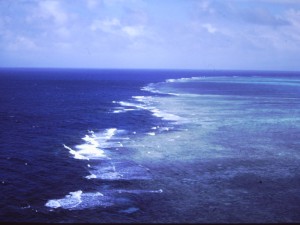New research has found that the Great Barrier Reef, as a whole, is a remarkably effective wave absorber, despite large gaps between the reefs. This means that landward of the reefs, waves are mostly related to local winds rather than offshore wave conditions.
As waves break and reduce in height over reefs, this drives currents that are very important for transport of nutrients and larvae. This reduction in wave height also has implications for shoreline stability.

The Great Barrier Reef in Australia is the largest coral reef system in the world, extending 2,300 km alongshore. The reef matrix is a porous structure consisting of thousands of individual reefs, with gaps in between. The porosity varies in that is it much lower in the north where the continental shelf is narrow and there is extensive reef flats; and is greater in the south where the shelf reaches up to 300 km wide and there are extensive lagoons.
Previously, there have been several studies investigating how individual reefs in the Great Barrier Reef influence ocean waves. However, this was the first, comprehensive, large-scale study of the influence of an entire offshore reef system on ocean wave transmission. The researchers used a 16 year-record of satellite altimeter measurements of wave heights.
The team was led by Dr Shari Gallop, Research Fellow in Geology and Geophysics at the University of Southampton, and included Dr Ivan Haigh, also from the University of Southampton; Professor Ian Young, Vice-Chancellor of the Australian National University (ANU); Professor Roshanka Ranasinghe, Professor of Climate Change Impacts and Coastal Risk (UNESCO-IHE, Deltares, ANU), and Dr Tom Durrant (Bureau of Meteorology, Australia).
The aim was to see how wave height reduction is influenced by the porosity of the reef matrix, sea level and wind speed. Dr Gallop says: “There was no evidence that in less porous areas wave heights are lessened. This is because individual reefs, like islands, cast a ‘wave shadow’ over a large area, so that a matrix of individual reefs is remarkably efficient at reducing waves.”
Dr Haigh says: “As sea level varies, due to tides and storm surges, the submergence of the reef in water also varies. Wave heights are not strongly affected by water level over the reef matrix.”
Professor Young adds: “A number of previous studies have investigated the attenuation (height reduction) of ocean waves as they spread across individual coral reefs. This research is unique as it looks at the impact of a large scale reef matrix, such as the Great Barrier Reef, on wave height. Such studies are important in providing wave climate information for physical, biological and planning processes in such areas.”
This new research, published in Coral Reefs, has important implications for wave modelling near reef systems. This is because models that consider individual reefs only may underestimate the wave reduction potential of a full reef matrix.
Professor Ranasinghe comments: “Plans are under-way to investigate the wave attenuation characteristics over the reef in more detail, using sophisticated numerical modelling. It is of critical importance to know the potential impacts of climate change effects such as sea level rise, and variations in wave conditions, on wave attenuation and current circulation on the Great Barrier Reef. This will aid in the sustainable management of this natural wonder, and the surrounding marine national park.”
Read the paper here